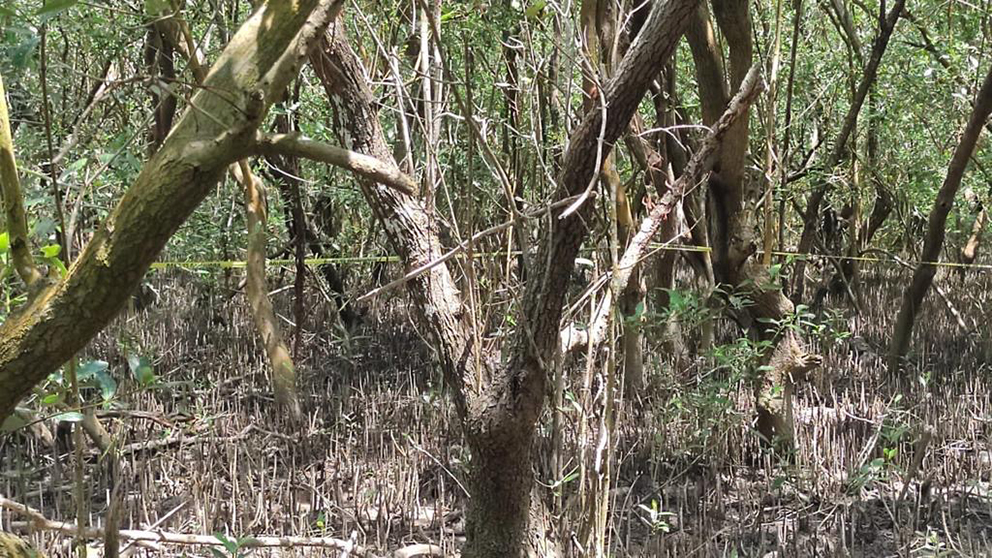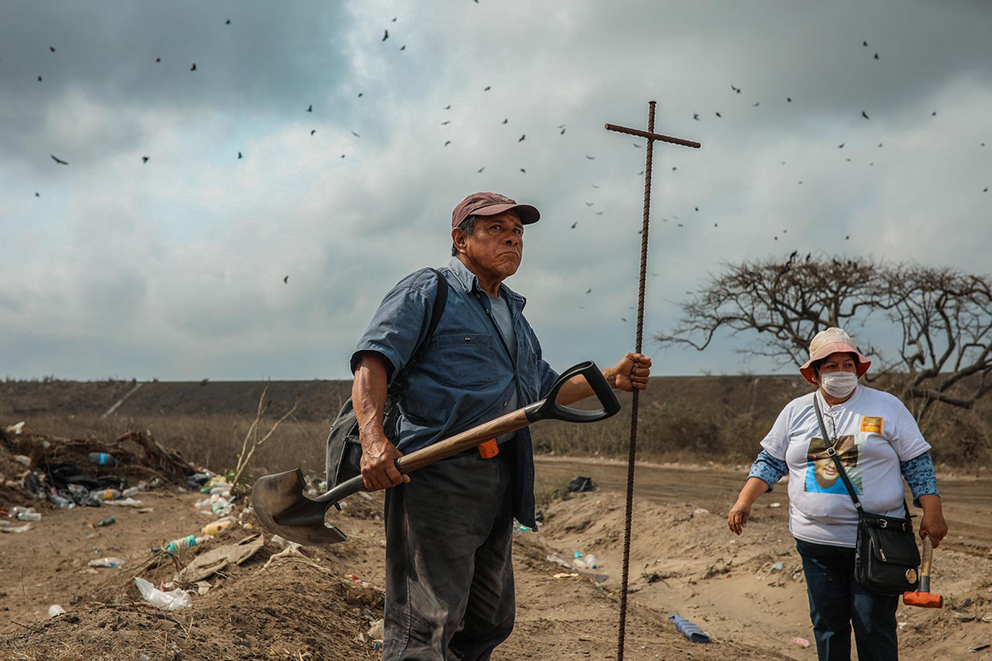Punta Puquita: clandestine graves in a Veracruz Mangrove
27 febrero, 2021
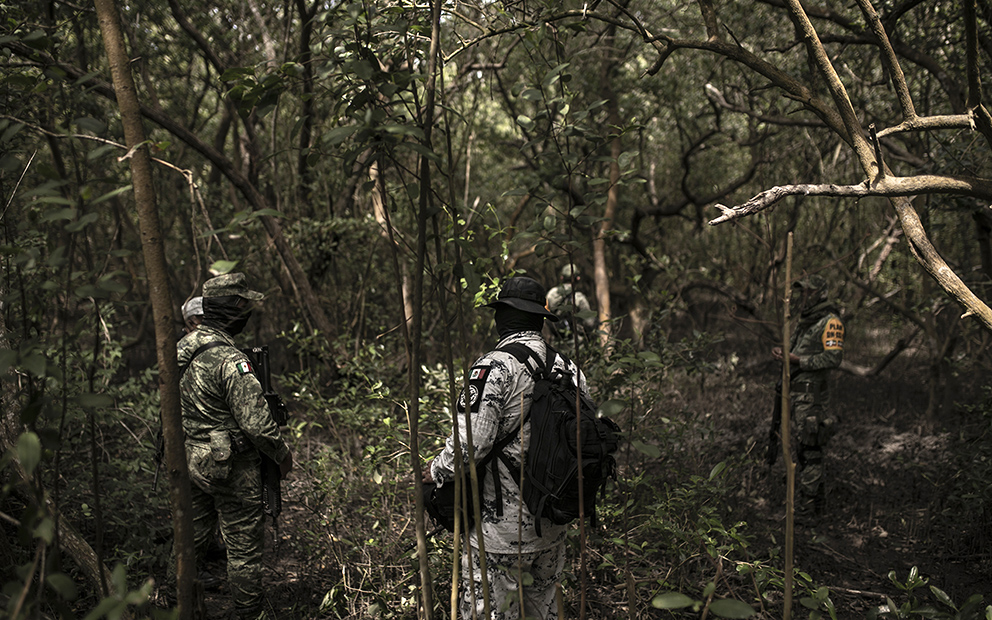
A clandestine grave was discovered in a remote, boat access only area considered a kind of paradise in the mangrove forests of Alvarado
Text: Víctor M. Toriz
Photos: Felix Márquez
Translation: Dawn Marie Paley
ALVARADO, VERACRUZ – The boot tracks in the mud of Punta Puquita, a small island located in the extreme south of the Alvarado Lagoon, are still fresh. Clandestine graves containing human remains were recently discovered in the area.
Silhouettes of armed men stand out against the roots of the mangrove forest, barely lit by the sun filtering through the brush, noise buffered by the north wind that blows at noon.
Members of the National Guard guarded the area where minutes before the first efforts had been made to mark off the areas where exhumations would be carried out. They placed red flags on the branches of the black mangroves that grow in the mud. Old tires, black plastic bags, a frying pan, and a glass jar were strewn around, indicating that the site was once frequented on a regular basis.
This terrain forms part of the clandestine cemetery which is buried under pockets of terrain where saltwater and freshwater meet, extending towards the Limón River on one side and towards the Gulf of México on the other.
Fishing boats belonging the residents of nearby towns pass by quietly every day, on the only route to the municipal center.
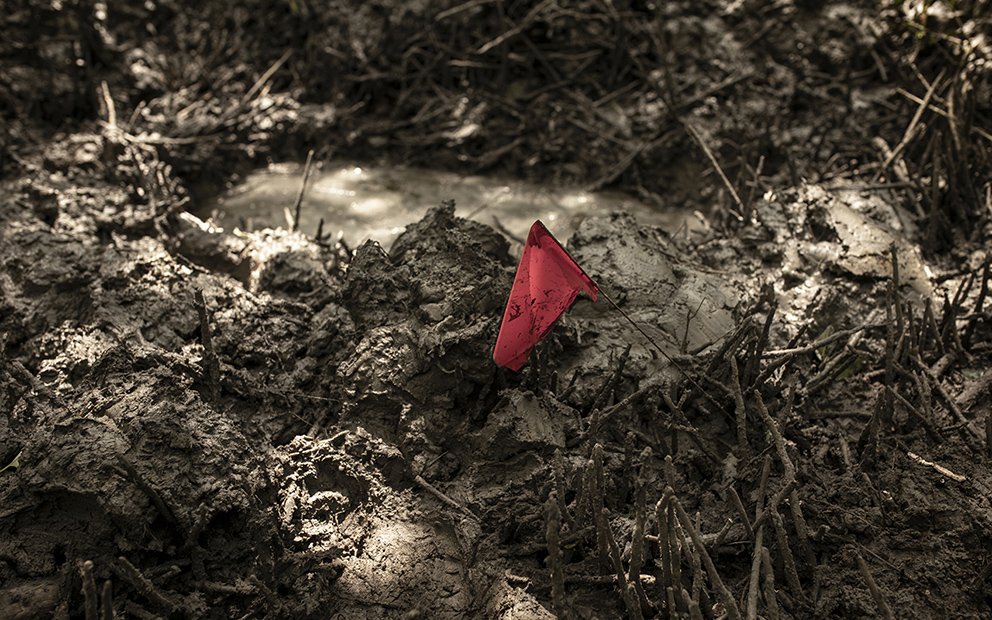
A year ago, Juan Ricardo noticed people in uniform searching the area with boats and even a helicopter; last month he saw them again, but he didn’t know why until the group of unknown people returned.
Since February 16, members of the National Search Commission have been carrying out reconnaissance in the region.
On February 17, the searchers confirmed the presence of bodies buried clandestinely in an area near Arbolillo, where graves were found in 2017, and where the process of processing over 2,000 bone fragments is ongoing.
It is the second day of exploration in the islet of Punta Puquita, a mangrove paradise where new clandestine graves were discovered.
A complicated search
To get to Punta Puquita, you have to travel upriver for at least 20 minutes from the municipal center of Alvarado.
Another way to access the area is to leave from the docks in communities along the edge of the lagoon, like Arbolillo and Los Cántaros; in either case, you must take a boat.
The landscape is reflected in the mirror of the water, the journey moves through the green of the mangroves and the blue of the clouds that extend to the horizon. The area is the last sanctuary of the manatees in Veracruz.
For the mothers of victims of disappearance, it is awful that a paradise like the Alvarado Lagoon was used to bury bodies in areas where nature created hidden pockets in the course of its growth.
Lucia Díaz Genao, founder and spokeswoman of the Solecito Collective of Veracruz, said that this is a painful discovery for mothers who are searching, and is one among many such cases that confirms the state is “a clandestine grave.”
“We’re talking about something absolutely aberrant, a state where we have graves truly all over, the catastrophe, the atrocity has no limits in Veracruz, you can see the sadism of the perpetrators in places like these, in the mangroves, which are wonderful places where nature is on full display; regardless, they are used for purposes as perverse as destroying people and human lives in these remote places.”
Díaz Genao says that the work to exhume the bodies is complicated because of the difficulties associated with accessing the territory, and the humidity to which the bodies were exposed. It is still not clear how long the bodies have been buried.
“This doesn’t surprise us, what does surprise us is that they’ve been able to bury these bodies in such difficult places, that are complicated to search and cause them to deteriorate more, because there’s water, it’s very alkaline and it filters through the bones. It’s very difficult to find DNA in bones that are exposed to humidity.”
Currently, Colectivo Solecito in Veracruz is carrying out searches in at least four locations in the state where there are clandestine graves: Arbolillo in Alvarado, Ixtaczoquitlán, La Guapota in Úrsulo Galván and Playa Vicente.
Following notification by authorities from the National Search Commission, they hope to join the searches in Punta Puquita, helping with the exhumation of bodies and searching larger areas.
In October of 2020, the federal government’s sub secretary of Human Rights, Alejandro Encinas Rodríguez, said that during the current government’s term 1,275 clandestine graves had been located, and 1,957 bodies had been exhumed from around the country, about 30% of the total between 2006 and 2018.
Ehen Encinas Rodríguez gave his report during President Andrés Manuel López Obrador’s morning press conference on October 7th, he also said that 49.5% of all of the clandestine graves in México were located in Veracruz, together with the states of Tamaulipas, Guerrero, Sinaloa, and Zacatecas.
Two municipalities in Veracruz were also on the list of 10 with the most clandestine graves: Úrsulo Galván and Playa Vicente, in second and sixth place.
With regards to the bodies found at Punta Puquita, state search commissioner Brenda Cerón said that a search was carried out together with the National Search Commission based on information regarding the possible existence of clandestine graves in the area.
Cerón said that, after determining strong probabilities [of finding graves] on one of the islands, the State Attorney General (FGE) was notified so that they could carry out searches in the area, in order to begin to enact the protocol of exploring the area and formally opening an investigation.
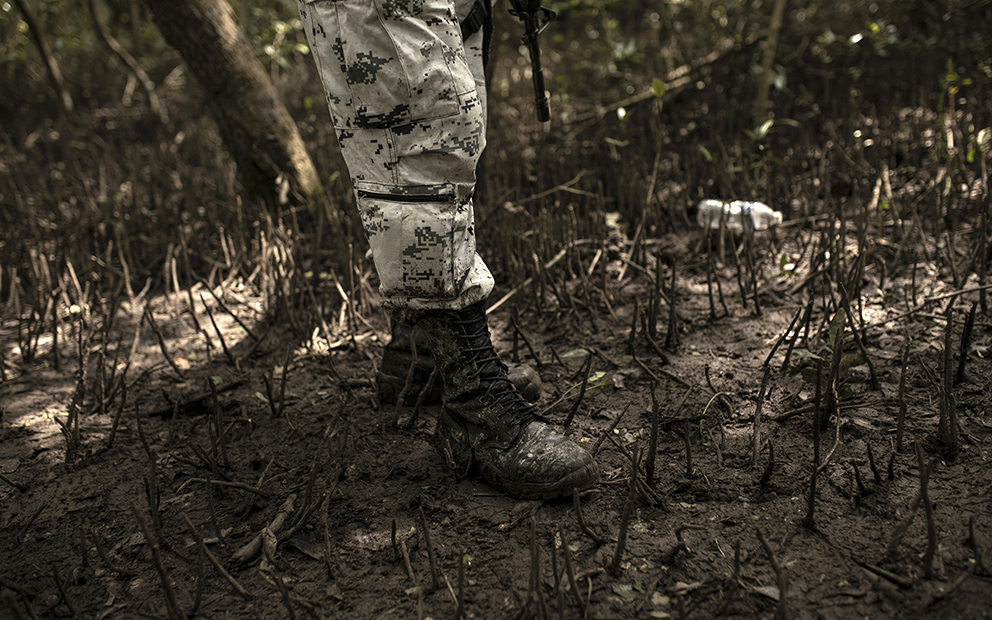
“During the reconnaissance, we were able to observe earthmoving and alterations in the area, which is why members of the National Commission and the State Commission began to enter the area and search for a positive, so they began to work there and did find a potential positive.”
Brenda Cerón said the members of search collectives in the state of Veracruz were notified so that they could accompany the searches in the area.
“Around that area, there were more visible alterations, which means there will likely be more remains found in that area, and so the members of the collectives in Veracruz were notified so that they are aware and they know that a work plan to search the area will be drafted.”
Arbolillo, precursor of clandestine graves
The discovery of clandestine graves on the islet of Punta Puquita isn’t the first in the region. In March of 2017, members of the Secretary of the Marines discovered burials in Arbollilo, Alvarado; in a ranch located on Federal Highway 180 that connects Matamoros with Puerto Juárez.
The discovery of these graves was possible following intelligence work to locate three marines who had been disappeared a month prior.
At that time, the FGE found 47 skulls, among them were the remains of the Marines. The search was then classified as complete.
A year later, in August of 2018, the Solecito Collective in Veracruz showed that the FGE didn’t completely search the area, when 32 more clandestine graves were found and it was claimed they were discovered in a different area.
The next month, mothers of the disappeared entered the site where the searches took place and found that there were negligence and omissions in the processing of the human remains, which were left abandoned and exposed.
In Arbolillo, the location of the graves extends about 200 meters inland from the edge of the lagoon and the watery area filled with mangrove roots.
Since last March, families of the disappeared and authorities have located 2,000 human remains in the clandestine cemetery in Arbolillo.
Four years after it was discovered, the site is still being explored by search collectives, which continue their work regardless of the COVID pandemic.
According to the Solecito Collective in Veracruz, just in the last two weeks six skulls were located in the third section of the area, which has been searched by families of the disappeared.
The National Search Commission has been carrying out searches in the area since Tuesday February 16, which continued Thursday with searches on Punta Puquita.
Bodies hidden in the insides of the mangrove
On the dock at Los Cántaros, Nicolás prepared to tie up his boat. He’s originally from one of the small communities of about 30 families located on the edge of the Alvarado Lagoon. His community is only accessible by boat.
In a local accent particular to the river area, he confirmed the presence of members of the National Guard in the Punta Puquita area. He didn’t seem surprised – rumors of discoveries of new clandestine graves had already spread among residents.
The first time he heard of something similar in the Alvarado Lagoon was in 2017, when similar burials were found in the Los Cosos ranch in the community of Arbolillo, on Federal Highway 180.
“It’s disturbing, it makes one wonder why people carry out atrocities, and what might have happened to us if we’d come in contact with one of them,” he said, stopping for a moment to comment on the situation before carrying on along his way.
For Nicolás it is obvious that the only way to bury bodies in the area is using boats, just as locals use boats in their daily lives. Nearly all the communities along the 16 kilometer lagoon are boat access only.
The lagoon is a complex system of bodies of water that are naturally interconnected, which means that long distances can be travelled on the water without being noticed by highway surveillance.
The Alvarado Lagoon empties into the Papaloapan River on one end and on the other it connects to the Limón River and Río Blanco. This route is regularly used by locals to travel to the municipality of Ignacio de la Llave, where it connects to another region known as the Mixtequilla, all without passing any highway checkpoints.
Félix Márquez is an independent photographer focussed on covering violence in Mexico, social conflicts, childhood and human rights in Latin America. He collaborates with various national and international media outlets.
Tweets:
Clandestine graves are discovered in the last refuge of the manatees in the state of Veracruz LINK
A powerful photo essay and Víctor M. Toriz on an extra complicated search for the disappeared in Veracruz LINK
Ayúdanos a sostener un periodismo ético y responsable, que sirva para construir mejores sociedades. Patrocina una historia y forma parte de nuestra comunidad.
Dona


